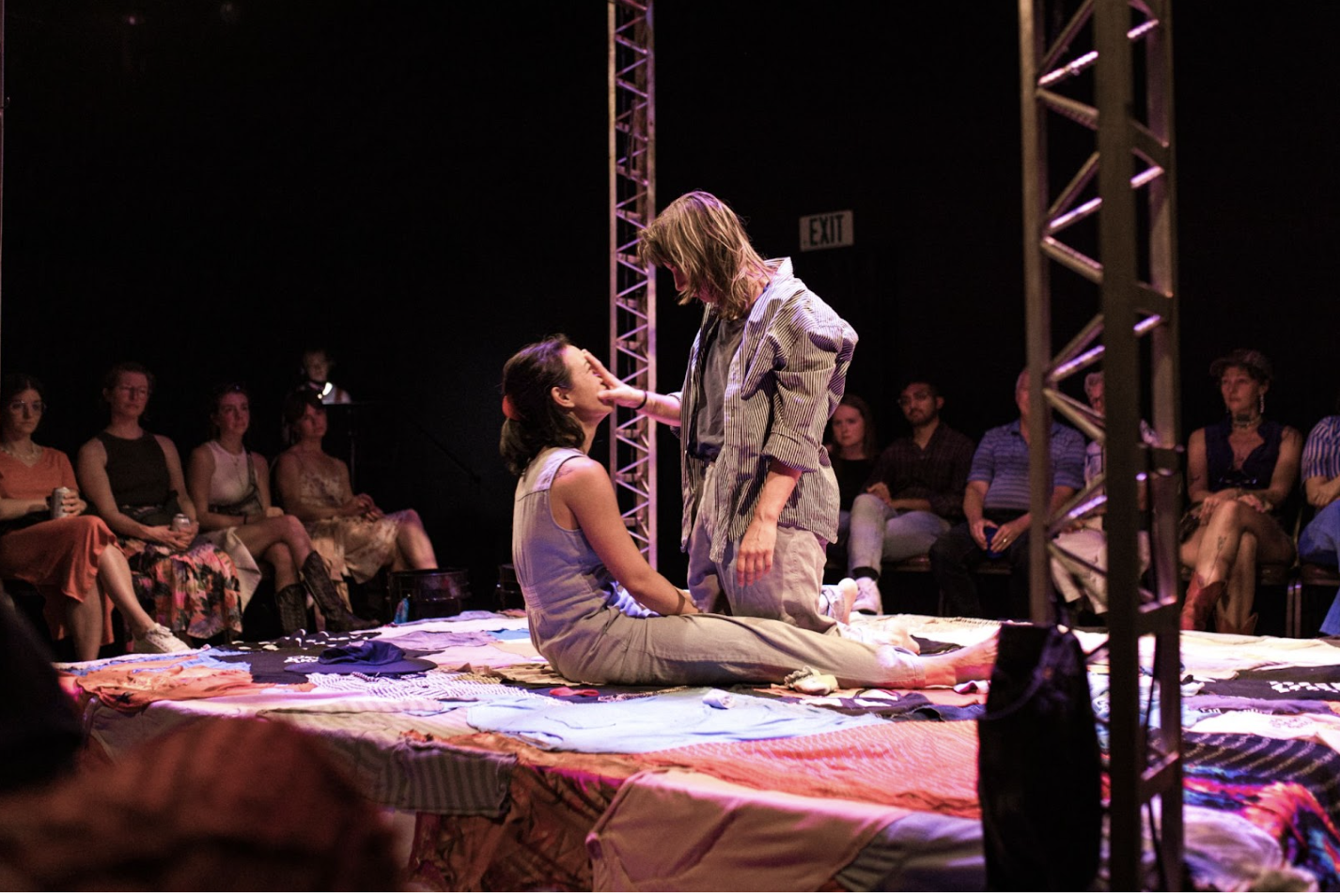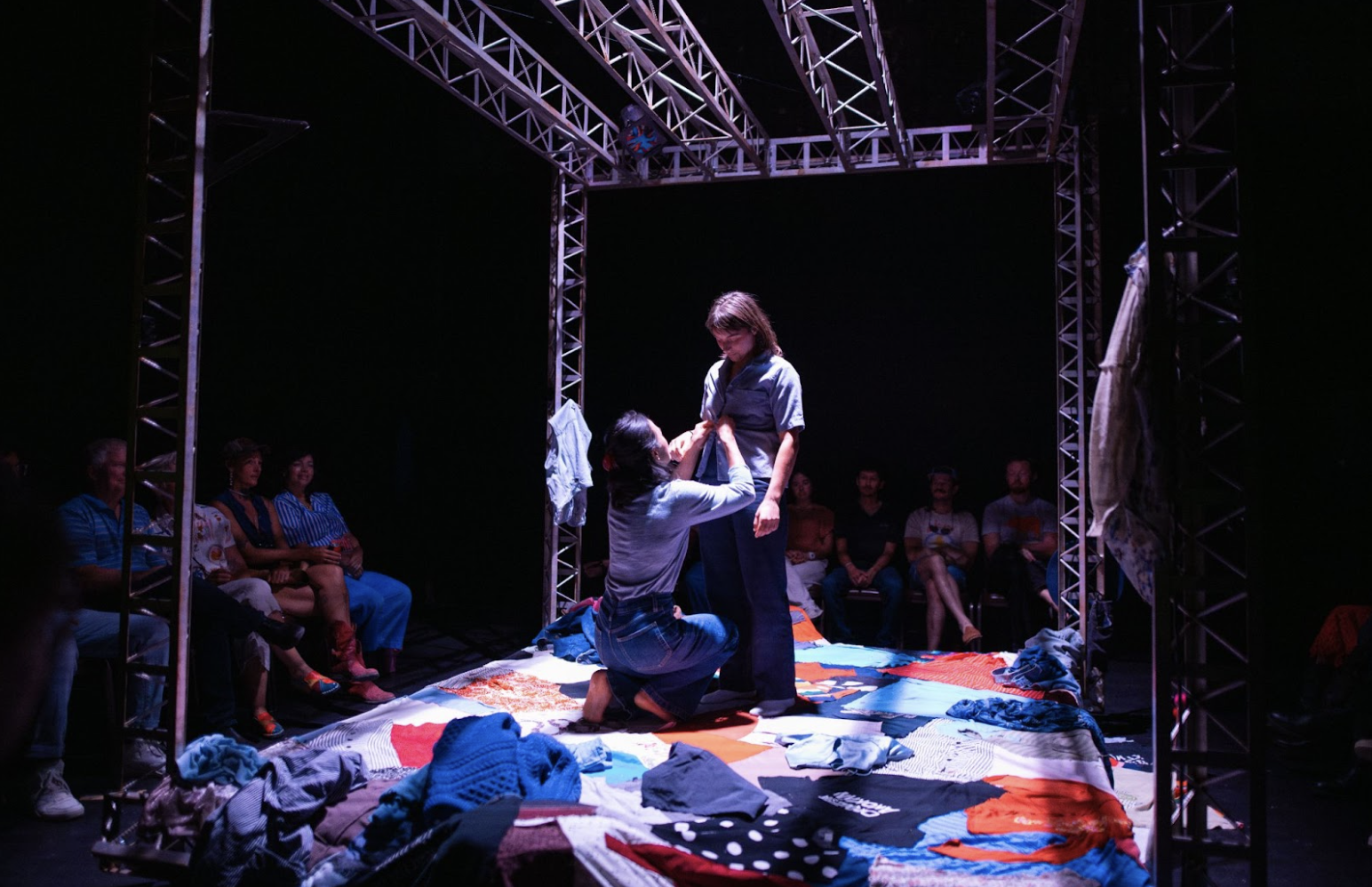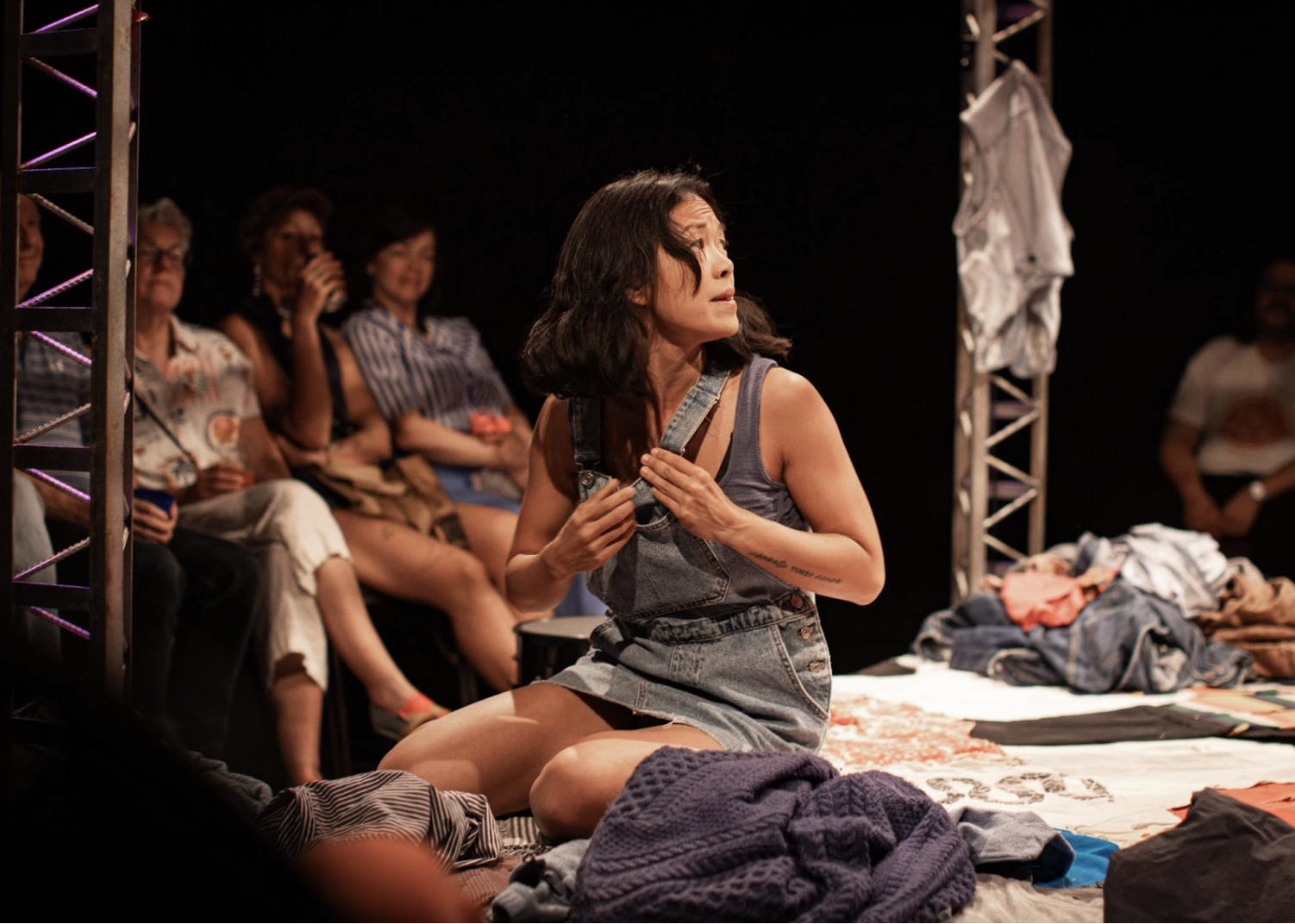Review: HOW SHOULD A CONVERSATION BE
by Sam Mayer for concept animals
All images courtesty of Joey Martinez
Austin, TX—There is almost no silence in Malena Pennycook’s How Should a Conversation Be?, which just finished ten days at Crashbox in Austin, Texas. The performance follows two characters, Kati and Terry, over multiple decades in a production directed by Dan Hasse starring Pennycook, Nancy Ma, and Caitlin Cobb-Vialet. In just one breakneck hour, Kati and Terry fall in love, get engaged, get married, have a kid, get into fights, grow old, and struggle to build their life together. There are no scene breaks; instead, Kati and Terry narrate everything. They narrate their actions, the passing of time, their spin-outs, their hopes and fears. Their constant, halting conversations reveal their ever-changing, uncertain interiority with the audience. The hour is an onslaught of language, an incessant, near-constant hum of words. Language is the ever-present, atom-sized building block of life in Pennycook’s play: imperfect, imprecise, jumping, moving, restless, relentless and constant, like time. And time always moves forward.
The audience enters through an oblong patch of green astroturf and crosses a darkened Crashbox to a ring of chairs surrounding a small platform of modular metal pieces covered in piles of clothes. The metal structure is called The SpaceCraft and is designed by LowDo Designs, an Austin-based architecture firm (LowDo recently showed work at the Venice Biennale). The SpaceCraft is made from materials found at a recycling scrap yard in Ghana. It is a modular maker-space, born out of DIY spirit. The SpaceCraft has traveled to Switzerland, Germany, and now Texas. Its next stop is Casa Marianella, an Austin non-profit supporting refugee women and children.
The SpaceCraft can be assembled and disassembled with endless customizable variations. It can mutate, warp, grow, or shrink to fill a need. This modularity is perfect for a performance in which language is as shifty, slippery, and mutable as the set.
Director Dan Hasse and artist Zipporah Nortion have arranged the SpaceCraft to playfully suggest each of Kati and Terry’s locations over their life together. A length of fabric becomes a dripping stalactite. A construction bucket becomes a Mexican cenote. A mobile of fuzzy blue hangers becomes a baby. A wisp of ribbon is an iPhone. Clothes are taken on and off with the speed and rhythm of Ma and Pennycook’s narration and they, too, become imprecise and inescapable. The costumes are by Kate Concannon–and there are lots of them–all looking vaguely the same in an uncanny way.
The play moves swiftly and elegantly through forty-plus years of Kati and Terry’s relationship, starting at their first meeting at the cringe Very Gay Beans coffee shop. Hasse keeps the action moving while Pennycook and Ma bring deep feeling and sensitivity to their performances in a delicate balancing act of inner and outer lives. Both performers have to switch modalities constantly, often within the same line. Reality and truth collapse between what is spoken and what is felt. Who are we, the audience, to these two people? Pennycook gives us almost obscene access to Kati and Terry’s interiority. All of this language! How can we trust it?
Early in the play, Terry says:
“You’re sizing me up.
You’re trying to decide if you can take me home.
I’m resisting filling the silence.
My eyes are scanning your body in a non-creepy kind of way.
I’m picturing you on a living room sofa
I’m picturing you late for your flight.
Nope, nevermind. I’m filling the silence.
Are you ever late for your flight?”
Terry narrates her interiority, her actions, and speaks to Kati. Everything becomes blurry. What does it mean to look at someone in a “non-creepy” way? The subjective is presented as narration and interiority as fact. Do we believe Terry? Is her definition of“non-creepy” the same as Kati’s, or as ours? Who is she speaking to: the audience or Kati? Is interiority a performance? If so, who is the audience? Constant tension exists between what is said aloud and what actually happens. It’s a tension of trust between the audience and the characters, between Kati and Terry, and between the characters and the world.
Later, Kati says:
“Or I could kiss you
I’m kissing you
I’m kissing you forever”
Or is the lover like an audience of faceless strangers, surrounding you in the dark, waiting for catharsis?
Non-speaking sounds have a different effect, like goo that slows time. There are several moments of live sound, most of which are performed by Caitlin Cobb-Vialet from a small electronic keyboard in the darkness of Crashbox. These moments elasticize time and introduce a third voice into the litany of Kati and Terry. The effect is shocking, halting. There is a world out there– the voice reminds us –outside of this story, outside of this theater. This third voice reemerges later in the performance, performing a magical act of stretching that enlarges the world of the play and the scope of time. Pre-recorded sound plays a small but effective role. Unlike Cobb-Vialet’s music, Kati and Terry notice the pre-recorded sounds. When Carole King plays, they dance. The pre-recorded sounds are real in the world of Kati and Terry. And in a single, pivotal moment (which I won’t give away), the tension between live and prerecorded sound–between who can hear what and why–is used by Cobb-Vialet, also the sound designer, to transcend language and splinter the world in a way that language, a building block, cannot.
Kati and Terry are confronted with the limits of language when tragedy, uncertainty, and betrayal strike. The emotional gulf between humans is so great; language is a pitiful ladder between us. Articulation can feel like a trap, like quicksand. But How Should a Conversation Be? reminds us that there is a freedom within this inability to articulate. The freedom to stop searching for the right words, and to find, instead, comfort in slipperiness. A desire for certainty is a fool's errand, certainty only lies in its opposite.
Words become other words. A bucket becomes a car. One hour in Crashbox becomes forty years in Colorado. Words are imperfect and connection is fleeting.
Art is a balm. It allows us to accept the inexpressible and see meaning in life through an accumulation of resonating experiences that vibrate and hum next to each other. After a while, they create a kind of meaning within us that resists language. What if connection and understanding come not through words, but through experience and time?
In the theater, audiences are used to experiments with time. They understand that they are seeing life sped up or slowed down. Conversations can stand in for whole discourses. When the lights go down and come back up, hours, days, and years might have passed. Sitting quietly in a dark room and watching people pretend to be other people– watching a chair pretend to be a different chair– is an act of giving time. The theater, in this way, replaces one time (the time it takes for the performance to be complete) with another form of time (story time). In giving up our time, we make the movement of time visible. In How Should a Conversation Be? we trade one logic for another. It is an act of collective generosity and collective dreaming towards new meaning.
How often do we not look at our phones for a whole hour? Sitting quietly in a dark space with other people becomes something radical as the corporate technosphere invades every single facet of the human experience. Pennycook’s play is reverent of this exchange, of time, of how time passes so fast that it is impossible to control. Language tries to provide an answer. Technology tries to provide an answer.
Kati says:
“I want you to know that my dream is to make this apartment completely compatible with my phone. I believe in technological solutions to human problems. I will be able to control it all with only a simple touch touch touch”
Algorithms want to harvest certainty for engagement. We are encouraged to instantly transform every experience into a bulleted list of lessons and revelations. But life isn’t like that. Life is a series of ineffable experiences and feelings built on trust and love. How Should a Conversation Be? emboldens us to reject certainty. Embrace language’s inabilities. A piece of ribbon is an iPhone. Lace and unlace your running shoes. Years pass. The water dripping off a rag is ice falling off a stalactite. Roll on the astroturf. It is grass. We mean things to other people without even realizing it. Grow old. Love. An hour is over. Time is a wave of the inexpressible, drowning in language. We emerge from the darkness into the parking lot. We return to our cars, our phones, to our lives. Shared time splinters as we peel off into the night.
FULL CREDITS:
By Malena Pennycook
Directed by Dan Hasse
with Malena Pennycook, Nancy Ma, and Caitlin Cobb-Vialet
Production Stage Manager Rose Gonzales
Lights Stephen Pruitt
Costumes Katie Concannon
Sound and Original Music Caitlin Cobb-Vialet
Props Zipporah Norton
Set Zipporah Norton
and LowDO Designs
Poster Design Julia Lopez-Mobilia
All photos by Joey Martinez
Read next: poolboy: don’t pick up








